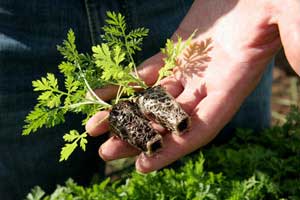Artesunate suppositories are economical, effective for malaria treatment
November/December 2010 | Volume 9, Issue 6
Giving emergency artesunate suppositories to children with suspected severe malaria before referring them for treatment is a cost-effective intervention that can substantially improve the management of childhood malaria in remote African settings, according to a Fogarty-supported study published recently in The Lancet.

Photo by WHO/S Hollyman
Artemisinin therapies for malaria are made with
extracts from A. annua plants, used in traditional
Chinese medicine for over 2,000 years.
The research team, led by Dr. Yesim Tozan of Boston University, studied a hypothetical cohort of 1,000 newborn babies through five years of age in high malaria transmission settings. The team assessed the costs and cost-effectiveness of artesunate treatment, followed by referral to a health facility, under a variety of intervention uptake and referral compliance scenarios.
The researchers estimated that the full uptake of artesunate treatment and full compliance with referral advice would avert 37 child deaths and 967 disability-adjusted life-years (DALYs) - a measure which combines years of life lost because of premature death, with years of life lived with disability - over five years. Across all scenarios, the study reported that the intervention could avert each DALY at a cost of $77 to $1,173.
"Compared with the interventions that target key childhood illnesses in sub-Saharan Africa, pre-referral artesunate treatment is among the most cost-effective, especially if the intervention uptake is moderate or higher," the researchers concluded.
WHO guidelines recommend the intervention but its use remains low, in part because of questions about cost.
"This study shows that rectal artesunate is highly cost-effective for saving lives of severely ill patients with malaria living not only at the end of the road, but where there is no road," said Dr. Joel G. Breman, Fogarty senior scientific advisor and a co-author on the study.
"There is now full justification to provide community health workers with life-saving rectal artesunate suppositories, training, and instructions for their use and referral follow-up, as part of the essential drug package," he said.
The study builds on previous research that found that the administration of one dose of rectal artesunate by a community health worker to a child with suspected severe malaria significantly reduced the risk of death and permanent disability. In addition to endangering the lives of young children, severe malaria has been associated with a range of developmental deficits.
Half of the world's population is at risk of malaria, with an estimated 243 million cases leading to nearly 863,000 deaths in 2008. Of those, 767,000, or 89 percent, occurred in Africa.
Prereferral rectal artesunate for treatment of severe childhood malaria: a cost-effectiveness analysis, The Lancet, 4 Dec. 2010, pgs. 1910-5.
To view Adobe PDF files,
download current, free accessible plug-ins from Adobe's website.